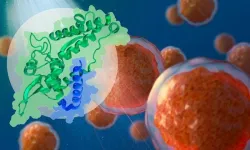(Press-News.org) New research finds around a quarter of Labrador retriever dogs face a double-whammy of feeling hungry all the time and burning fewer calories due to a genetic mutation.
This obesity-driving combination means that dog owners must be particularly strict with feeding and exercising their Labradors to keep them slim.
The mutation is in a gene called POMC, which plays a critical role in hunger and energy use.
Around 25% of Labradors and 66% of flatcoated retriever dogs have the POMC mutation, which researchers previously showed causes increased interest in food and risk of obesity.
The new study reveals how the mutation profoundly changes the way Labradors and flatcoated retrievers behave around food. It found that although they don’t need to eat more to feel full, they are hungrier in between meals.
In addition, dogs with the POMC mutation were found to use around 25% less energy at rest than dogs without it, meaning they don’t need to consume as many calories to maintain a healthy body weight.
“We found that a mutation in the POMC gene seems to make dogs hungrier. Affected dogs tend to overeat because they get hungry between meals more quickly than dogs without the mutation,” said Dr Eleanor Raffan, a researcher in the University of Cambridge’s Department of Physiology, Development and Neuroscience who led the study.
She added: “All owners of Labradors and flatcoated retrievers need to watch what they’re feeding these highly food-motivated dogs, to keep them a healthy weight. But dogs with this genetic mutation face a double whammy: they not only want to eat more, but also need fewer calories because they’re not burning them off as fast.”
The POMC mutation was found to alter a pathway in the dogs’ brains associated with body weight regulation. The mutation triggers a starvation signal that tells their body to increase food intake and conserve energy, despite this being unnecessary.
The results are published today in the journal Science Advances.
Raffan said: “People are often rude about the owners of fat dogs, blaming them for not properly managing their dogs’ diet and exercise. But we’ve shown that Labradors with this genetic mutation are looking for food all the time, trying to increase their energy intake. It’s very difficult to keep these dogs slim, but it can be done.”
The researchers say owners can keep their retrievers distracted from this constant hunger by spreading out each daily food ration, for example by using puzzle feeders or scattering the food around the garden so it takes longer to eat.
In the study, 87 adult pet Labrador dogs - all a healthy weight or moderately overweight - took part in several tests including the ‘sausage in a box’ test.
First, the dogs were given a can of dogfood every 20 minutes until they chose not to eat any more. All ate huge amounts of food, but the dogs with the POMC mutation didn’t eat more than those without it. This showed that they all feel full with a similar amount of food.
Next, on a different day, the dogs were fed a standard amount of breakfast. Exactly three hours later they were offered a sausage in a box and their behaviour was recorded. The box was made of clear plastic with a perforated lid, so the dogs could see and smell the sausage, but couldn’t eat it.
The researchers found that dogs with the POMC mutation tried significantly harder to get the sausage from the box than dogs without it, indicating greater hunger.
The dogs were then allowed to sleep in a special chamber that measured the gases they breathed out. This revealed that dogs with the POMC mutation burn around 25% fewer calories than dogs without it.
The POMC gene and the brain pathway it affects are similar in dogs and humans. The new findings are consistent with reports of extreme hunger in humans with POMC mutations, who tend to become obese at an early age and develop a host of clinical problems as a result.
Drugs currently in development for human obesity, underactive sexual desire and certain skin conditions target this brain pathway, so understanding it fully is important.
A mutation in the POMC gene in dogs prevents production of two chemical messengers in the dog brain, beta-melanocyte stimulating hormone (β-MSH) and beta-endorphin, but does not affect production of a third, alpha-melanocyte stimulating hormone (α-MSH).
Further laboratory studies by the team suggest that β-MSH and beta-endorphin are important in determining hunger and moderating energy use, and their role is independent of the presence of α-MSH. This challenges the previous belief, based on research in rats, that early onset human obesity due to POMC mutations is caused only by a lack of α-MSH. Rats don’t produce beta-melanocyte stimulating hormone, but humans and dogs produce both α- and β-MSH.
END
Genetic mutation in a quarter of all Labradors hard-wires them for obesity
2024-03-06
ELSE PRESS RELEASES FROM THIS DATE:
MIT scientists use a new type of nanoparticle to make vaccines more powerful
2024-03-06
CAMBRIDGE, MA -- Many vaccines, including vaccines for hepatitis B and whooping cough, consist of fragments of viral or bacterial proteins. These vaccines often include other molecules called adjuvants, which help to boost the immune system’s response to the protein.
Most of these adjuvants consist of aluminum salts or other molecules that provoke a nonspecific immune response. A team of MIT researchers has now shown that a type of nanoparticle called a metal organic framework (MOF) can also provoke a strong immune response, by activating the innate immune system — the body’s first line of defense against ...
A noninvasive treatment for “chemo brain”
2024-03-06
CAMBRIDGE, MA -- Patients undergoing chemotherapy often experience cognitive effects such as memory impairment and difficulty concentrating — a condition commonly known as “chemo brain.”
MIT researchers have now shown that a noninvasive treatment that stimulates gamma frequency brain waves may hold promise for treating chemo brain. In a study of mice, they found that daily exposure to light and sound with a frequency of 40 hertz protected brain cells from chemotherapy-induced damage. The treatment also helped to prevent memory loss and impairment of other ...
Film festivals are becoming more diverse in several ways, new study reports
2024-03-06
A group of Tallinn University researchers has published an innovative study that sheds light on the intricate dynamics of the global film festival circuit, revealing insights into diversity and public value creation within the industry. The research demonstrates that festival programming has become more thematically diverse, and the inclusion of films by women creatives has increased between 2012–2021.
The study “Quantifying the global film festival circuit: Networks, diversity, and public value creation,” published open access in the PLOS ONE journal, provides a comprehensive analysis of over 600 film festivals worldwide, spanning a period ...
New hydrogen producing method is simpler and safer
2024-03-06
Researchers in Sweden unveiled a new concept for producing hydrogen energy more efficiently, splitting water into oxygen and hydrogen without the dangerous risk of mixing the two gases.
Developed at KTH Royal Institute of Technology in Stockholm, the new method decouples the standard electrolysis process for producing hydrogen gas, which splits water molecules by applying an electric current. In contrast with prevailing systems it produces the resulting oxygen and hydrogen gases separately rather than simultaneously in the same cell, where they need to be separated by membrane barriers
That separation eliminates the possibility of the gases mixing with the risk of explosions, says ...
Studying the relationship between cancer-promoting proteins
2024-03-06
By Simonne Griffith-Jones, Predoctoral Fellow, EMBL Grenoble
Researchers from the Bhogaraju Group at EMBL Grenoble have gained new insights into how a cancer-relevant family of proteins bind their targets. The results of the study, published in The EMBO Journal, could potentially help in the development of drugs against certain chemotherapy- and radiotherapy-resistant cancers.
The Melanoma Antigen Gene (MAGE) family consists of more than 40 proteins in humans, most of which are only present in the ...
UTA educating schoolchildren about solar eclipse
2024-03-06
The University of Texas at Arlington has received a grant from the National Science Foundation (NSF) to support educational activities related to the upcoming eclipse.
UTA faculty and graduate students are visiting elementary, middle and high schools in the DFW area in March to give talks to about 4,000 students explaining the natural phenomena occurring during the eclipse and the physics behind it. UTA will also provide special eclipse glasses for students to use to avoid eye damage.
The $50,000 grant will also provide for about 1,500 students to take field trips to the UTA Planetarium, one of the three largest in Texas, to learn ...
Espresso yourself: Wearable tech measures emotional responses to coffee
2024-03-06
Researchers in Italy have introduced a novel approach for assessing the quality of coffee. In a pioneering new study, they have demonstrated the feasibility of using wearable technology to measure the emotional responses of coffee experts during tastings.
Published in SCI’s Journal of the Science of Food and Agriculture, the study provides an innovative solution for reducing judgement biases that can result from traditional and more subjective methods of coffee quality assessment.
Coffee is one of the most popular and widely consumed beverages in the world, ...
What drives ‘drug-induced homicide’ prosecutions in North Carolina?
2024-03-06
A new study finds that prosecutors in North Carolina believe “drug-induced homicide” (DIH) laws are effective at both reducing drug overdoses in a community and curtailing the distribution of illicit drugs. These beliefs are worth noting because there is no evidence to support them, while there is evidence that DIH prosecutions make people in affected communities less likely to call 911 – and may actually increase the number of overdoses in a community.
DIH laws, also called “death by distribution” or “delivery resulting in death” laws, ...
Psychosocial stressors linked to higher inflammation in Black pregnant women
2024-03-06
UNIVERSITY PARK, Pa. — Living in neighborhoods with more white residents and greater lifetime experiences of racial discrimination are linked to increased systemic inflammation during pregnancy among Black women, according to new research led by a team from Penn State. The study, published in the February issue of the journal Brain, Behavior, & Immunity – Health, found that these social-environmental factors were associated with higher levels of a protein that has been connected to chronic stress and an elevated risk of ...
Amyloid blood levels associated with brain changes in Alzheimer's study
2024-03-06
New research published today suggests there is a link between abnormal blood levels of amyloid — a protein associated with Alzheimer’s disease — and subtle changes in brain microstructures on a type of MRI, findings that could lead to a new way to detect Alzheimer’s earlier in people with no clinical signs.
Researchers analyzed the results of 128 human participants with and without dementia from the 1Florida Alzheimer’s Disease Research Center who underwent imaging scans using an established diagnostic tool called positron emission tomography, or PET, which can detect amyloid plaques in the brain, a hallmark ...







